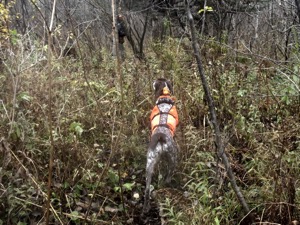
Helpful Advice and Other Things
Received an email from Linehan Outfitters in Montana yesterday - if you're ever in Montana, particularly in the northwest part of the state, and are looking for an excellent time out hunting (upland birds, big game) or fishing (flyfishing trips on the Yaak, Kootenai, Missouri, and Clark Fork, among other rivers) - look them up. Tim and Joanne run a first class guide service and have been recognized for several awards, among them Montana Outfitter of the Year - needless to say, you better book early!
Anyway, the following grouse hunting tips were in the newsletter from Tim Linehan, and are worth a read, especially if you like to use the "skirmish line" tactic that many of us use when we have a group going through the woods or working a road edge. Safety and organization should be the top priorities when employing this technique, so read carefully and try to put it into practice. Thanks to Tim for letting me share this with all of you.
Grouse Hunting - Holding The Line
Here are three strategies to help you and your hunting partners stay in line and stay safe on your next outing.
1. Choose a quarterback for your hunt. Have a look at the area you intend to hunt on a map or gps and assign one person to take charge and choreograph the effort. By allowing one person the take charge on an agreed upon hunt strategy, you minimize the possibility of someone going rogue and ending up in front of the guns.
2. Regardless of whether you’re the quarterback or not, communicate vocally and frequently with your hunting partners. Every minute or two everyone in the party should call out to the person immediately next to them to assure everyone is still on line. If you have several people in your party, it’s best to call out to the person next to you and then have everyone else call out down the line as well. There’s no such thing as too much communication in a thick grouse cover.
3. Be aware of the different paces each of you employ while traveling through the cover. Experience and physical health certainly influence your partners’ pace. Size up the group dynamic in the first two or three hundred yards and have everyone adjust accordingly. Be decisive and thoughtful about accommodating your partners’ abilities.
4. Use a fixed point to help you stay on line. Topography or vegetation obstructions are the number one reason the line breaks down while grouse hunting. One small hill, or one patch of blowdown that someone encounters can send them inadvertently right in front of other guns. Every one hundred yards or so and based on your quarterback’s direction, choose a tree, a stump, anything, and head straight for that point. Look up occasionally, maintain good and true direction, and do not deviate. When grouse hunting compasses and GPS help to this end but it’s far easier to look up occasionally and maintain a bearing on a big, lone pine tree than it is to constantly have to check something hanging around your neck or in your pocket. I learned very early from an old New Hampshire grouse hunter to go through obstructions whenever possible, and not around them provided you weren’t compromising any safety rules.
5. If the line breaks down and someone is lagging behind or you notice someone out in front, stop the hunt and any shooting immediately. Regardless of what’s going on, and even if you’re into the mother lode of ruffed grouse and your dog is locked up on point or flushing birds from underfoot, this is obviously one of the worst case scenarios and make no exceptions to this rule. It’s only a little bird...and hunting is definitely not bigger than life.
Staying in line while hunting grouse is an absolute. By keeping these five common sense approaches and strategies in mind while hunting dense grouse covers, you will find it easier to maintain direction and heading which will make for a better and much safer hunt in the end.
